Cosmology
1/77
There's no tags or description
Looks like no tags are added yet.
Name | Mastery | Learn | Test | Matching | Spaced |
|---|
No study sessions yet.
78 Terms
definition of 1 astronomical unit
the mean distance between the Sun and the Earth. 1 AU = 1.50x1011 m
definition of the light year.
The distance that light travels in a year whilst passing through a vacuum
value of a light year in metres.
9.5×1015m
Identify the option which corresponds to the closest estimate of the distance from the Sun to its nearest star
4.25 light years
Identify the option which corresponds to the nearest estimate of the diameter of the Milky Way galaxy
1.00×105 light years
Identify the option which corresponds to the nearest estimate of the distance from the Milky Way to the nearest galaxy
2.50×106 light years
Identify the option(s) which is (or are) used as units to measure angle in astronomy
Arcseconds
Arcminutes
Calculate the number of degrees in an angle of 34 arcminutes. Give your answer to 2 significant figures.
By definition, there are 60 arcminutes in 1 degree.
This means in 1 arcminute, there are 1/60 degrees
Calculate the number of degrees in an angle of 34 arcminutes. Give your answer to 2 significant figures.
This is summarised by the equation: Number of Degrees=Number of Arcminutes/60
Substituting the value given in the question: Number of degrees=(34)/60=0.57
Calculate the number of arcseconds in an angle of 21.4 arcminutes. Give your answer to 3 significant figures
60×21.4=1284 arcseconds
The diagram below shows the configuration of the Sun, the Earth and a distant star.
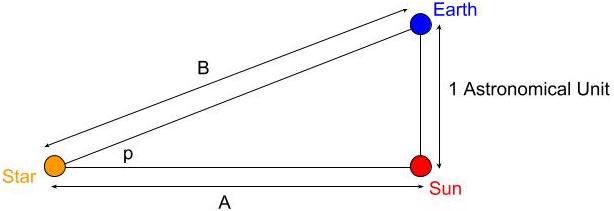
Identify the option below that states the correct definition of 1 parsec.
1 parsec is defined as the distance A when the angle p is 1 arcsecond
The diagram below shows the configuration of the Sun, the Earth and a distant star.
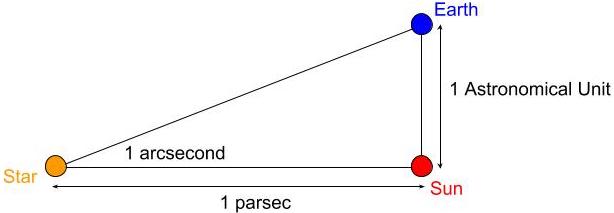
If 1 astronomical unit=1.50×1011m, calculate the value of 1 parsec in metres. Give your answer to 2 significant figures.
(1.5×1011)/tan(2.78×10-4)=3.1×1016m
Calculate the angle P that the star makes between the Earth and the Sun (in arcseconds) if the distance from the Sun to the star is 5.94 parsecs. Give your answer to 2 significant figures.
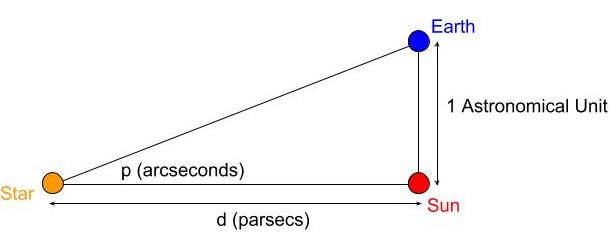
p=1/d
p=1/5.94=0.17 arcseconds
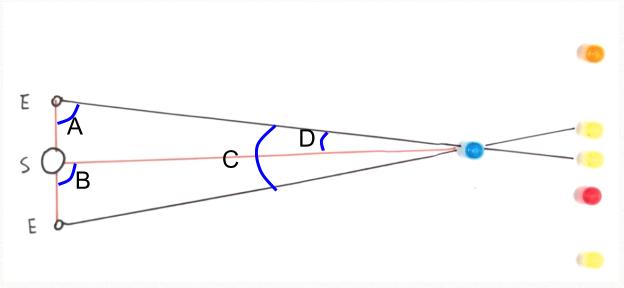
The parallax angle can be used to measure the distance to stars.
Choose the option that gives the correct position of the parallax angle on the diagram below, where ‘S’ is the Sun, ‘E’ is the Earth (at two instances, 6 months apart), the blue dot is a star, and the other dots are background stars or galaxies
D
The parallax angle is the angle made between a straight line from the sun to the star and the line from the star to the Earth. It gives the apparent shift of a relatively close star against a backdrop of more distant stars when the close star is viewed from two different positions
The parallax angle, p, can be used to measure the distance to stars, d.
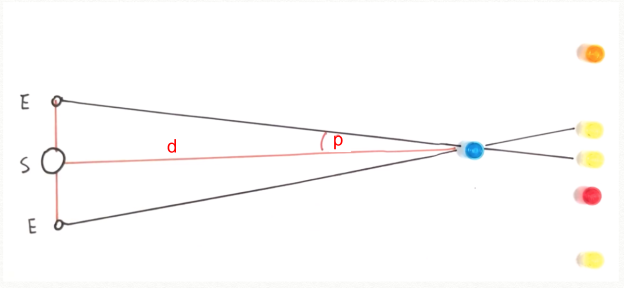
Choose the option that gives the relationship between the distance to the stars, d and the parallax angle, p.
d=1/p
The diagram below shows the position of the parallax angle, p.
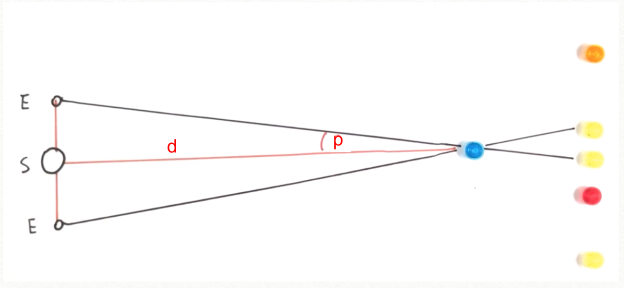
Choose the units used to measure the parallax angle.
arcseconds
1 arcsecond=1/3600 degree
In the formula d=1/p,d represents the distance and p the parallax angle.
Choose the option that describes what the 1 in the formula represents
the mean Earth - Sun distance in astronomical unit
The diagram below shows the distance to a star, d.
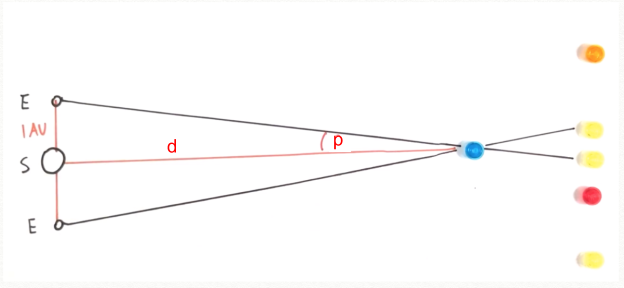
Choose the units used to measure the distance to a star, p when found using d=1/p.
parsecs
The equation d=1/p cannot be used to find the distance to all the visible stars.
Choose the correct description of the limitations of the equation d=1/p
The d=1/p equation is limited to stars up to 100 pc from Earth, because after this point, the angle ‘p’ becomes too small to measure accurately
1 Arcminute
1/60th of a degree. No. of degrees = No. of arcminutes / 60
1 Arcsecond
1/60th of an arcminute, 1/3600th of a degree. No. of degrees = No. of arcseconds / 3600
Parallax angle
the angle of apparent shift when a relatively close star is viewed from two different positions against a background of distant stars
Parsec
The distance at which 1 AU subtends an angle of 1 arcsecond.
d = 1 / p, where ‘d’ is measured in parsecs and ‘p’ is the angle in arcseconds
The Cosmological Principle states that on a large scale the universe is:
Isotropic, homogeneous and that the laws of physics are universal across the universe
What does the term isotropic mean?
Looks the same in every direction
What does the term homogeneous mean?
matter is evenly distributed throughout the Universe
What does the term universal mean?
Applies everywhere
The Doppler effect describes how a wave’s properties change as a result of the relative motion between the wave source and the observer. Identify the wave properties that change if the wave source moves towards or away from the observer (or the observer moves towards or away from the source).
Frequency
Wavelength
The below images show a sound wave source (the black dot) and the peaks of the waveform (the circles/ellipses) travelling away from the source. The wave medium is air. Identify the diagram showing the waveform of a source moving towards the observer.
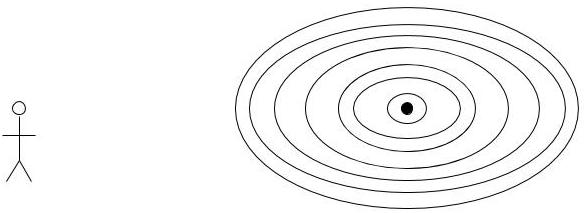
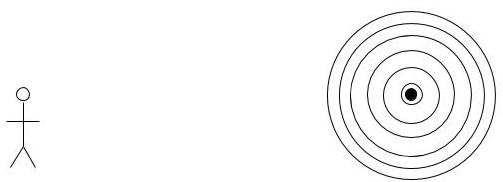
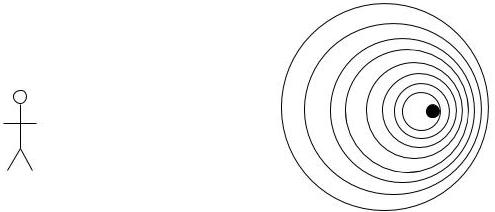
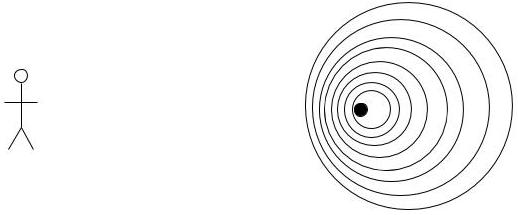
D
The below images show a sound wave source (the black dot) and the peaks of the waveform (the circles/ellipses) travelling away from the source. The wave medium is air. Identify the diagram showing the waveform of a source moving away from the observer.
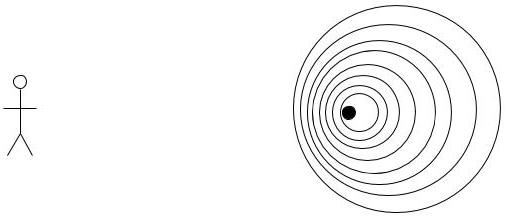
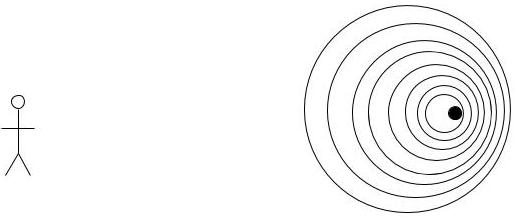
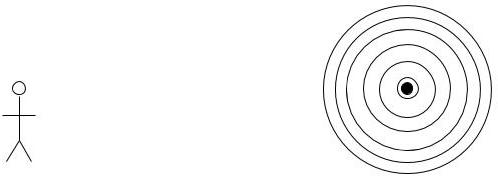
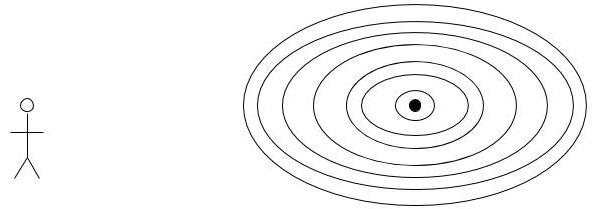
B
The frequency of waves from a source moving towards an observer is——1)—the frequency of waves from the same source if it was stationary relative to the observer
The wavelength of waves from a source moving towards an observer is——2)—-the wavelength of waves from the same source if it was stationary relative to the observer
1) higher than
2)lower than
The frequency of waves from a source moving away from an observer is——1)—the frequency of waves from the same source if it was stationary relative to the observer.
The wavelength of waves from a source moving away from an observer is——2)———the wavelength of waves from the same source if it was stationary relative to the observer
1) lower than
2)higher than
An astronomical source emits radiation of wavelength λ. The source is moving at speed v relative to the Earth, and the radiation will be measured to have wavelength λobs on the Earth.
If c is the speed of light in vacuum, identify the option below that correctly states the equation describing the change in wavelength produced by the Doppler effect for this radiation.

The Doppler shift is given by Δλ/λ≈v/c, where Δλ=λobs−λ
λ=not observed
An astronomical source emits radiation of frequency f. The source is moving at speed v relative to the Earth, and the radiation will be measured to have frequency fobs on the Earth. If c is the speed of light in vacuum, identify the option below that correctly states the equation describing the change in frequency produced by the Doppler effect for this radiation.
The Doppler shift is given by Δf/f≈v/c, where Δf=fobs−f.
Identify the experimental technique that can be used to investigate the velocities of distant stars and galaxies relative to the Earth.
Absorption spectra
The absorption spectrum of a galaxy that is stationary relative to to the Earth is shown below.
Identify the option that shows the absorption spectrum of the same galaxy if it were moving towards the Earth.


The absorption spectrum of a galaxy that is stationary relative to to the Earth is shown below.
Identify the option that shows the absorption spectrum of the same galaxy if it were moving away from the Earth.


when does blue shift occur?
Blue shift occurs when the wavelength of astronomical radiation decreases as a result of the source moving towards the Earth
when observed wavelengths appear shorter due to the wave source and observer moving towards each other
when does red shift occur?
Red shift occurs when the wavelength of astronomical radiation increases as a result of the source moving away from the Earth
when observed wavelengths appear longer due to the wave source and observer moving away from each other
Doppler Effect
comparative to observation without relative motion, the Doppler Effect is the change in frequency and wavelength due to relative motion between wave source and observer
What does redshift tell us about the galaxies producing the light?
The galaxies are moving away from us
When a light source source moves away from us, the wavelengths become longer.
∘∘ The faster the light source moves, the larger the shift in wavelength.
∘∘ So, more red shift means a faster moving galaxy.
graph for recessional velocity and distance
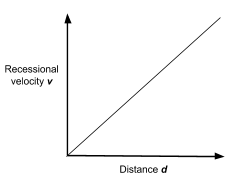
Hubble’s law, which connects the recessional velocity in km/s against distance, d, measured in megaparsec, is given by:
v=Hod
What is Ho called?
hubbles constant
Which two of the following are possible units for Ho:
s-1, km s-1 Mpc-1
The big bang theory is an important theory in cosmology. Identify all the statements from below that are used to characterise the big bang theory
The big bang theory suggests that the beginning of space and time came from a singularity (a single point).
Space expanded rapidly outwards during the big bang
Hubble’s law is a piece of evidence for the big bang.
The cosmic microwave background radiation is a piece of evidence for the big bang.
None of the competing theories of the origin of the Universe had predicted or could explain the cosmic background radiation, and so the Big Bang Theory was widely accepted as the origin of the Universe
Hubble’s law is a piece of evidence to support the Big Bang Theory. Choose the correct description of Hubble’s law
Hubble’s law shows that distant galaxies are receding from us
Hubble’s law shows that galaxies are receding from us and gives evidence for the expansion of the universe.
recessional speeds of distant galaxies
If space was expanding in all directions, we would expect to see more distant galaxies have higher recessional speeds
statements from below that are used to characterise the cosmic background radiation
The cosmic background radiation was predicted by the Big Bang Theory before it was discovered.
The cosmic background radiation was found in 1964 by Robert Wilson and Arno Penzias.
The cosmic background radiation is observed in every direction in the universe at the same temperature, which suggests that all of the universe was at one point in the same location at some earlier point
The cosmic background radiation and Hubble’s law are equivalent
When the universe was young, it was hot and was filled with high energy photons.
Choose the correct option that describe the change, if any, to the photons as the universe expanded.
As space expanded, the wavelength of the photons were stretched out to longer wavelengths.
∘∘ We now detect these wavelengths as the cosmic background radiation
When the universe was young, it was very hot, and expansion has cooled the universe to a an approximate temperature today of 2.7 K.
Identify the region of the electromagnetic spectrum the peak wavelength of the radiation emitted by the universe if treated as the blackbody radiator.
Microwave region
Select the correct assumptions that needs to be made in order to calculate the age of the universe from Hubble’s Law
The rate of expansion of the Universe has been constant since the beginning of the Universe
Choose the correct option that can be deduced if we assume that the rate of expansion has been constant
the recessional speed, v, of any particular galaxy has been constant since the start of the universe
Each of the letters below corresponds to an event that occured within the first second of the life of the universe.
P) Inflation
Q) Formation of hadrons
R) Formation of quarks and leptons
S) Big Bang
Identify the option that puts these events in the correct order, starting from the earliest
S,P,R,Q
During the inflation of the early universe, the universe was composed of high energy gamma photons. Identify the option that corresponds to the time after the Big Bang at which inflation began
10-35s
During inflation, fundamental particles form via a mechanism involving the Higgs Boson. Identify the time after the Big Bang at which the formation of fundamental particles begins.
10-6s
During inflation, after the fundamental particles have formed, they merge to form composite particles called hadrons. Identify the time after the Big Bang at which the formation of hadrons begins.
10-3s
As the age of the universe increases, the temperature of the universe also changes. Identify the option that correctly gives the temperature change from the beginning of inflation and 1 second after the Big Bang, when matter creation stops.
T decreases from 1028K to 109K
As the time after the Big Bang exceeds 1 second, subatomic particles begin to fuse together. Identify the option that states the time after the Big Bang that protons and neutrons fused together to form deuterium and helium nuclei
102s
After the nuclei of light elements have formed, the temperature of the universe must fall further before nuclei and electrons can attract each other and form atoms. Identify the option that states the time after the Big Bang that atoms can begin to form.
3.80×105 years
The cosmic microwave background radiation consists of electromagnetic radiation dating back to the early universe. State whether the Cosmic Microwave Background radiation originated from before, after or at the same time as the fusion of nuclei and electrons to form atoms
The cosmic microwave background radiation originated at the same time as the formation of atoms
After the atoms of light elements have formed, they can coalesce to form stars. Identify the option that states the time after the Big Bang that stars began to form
3×107 years
State whether the Milky Way galaxy began to form before, after or at the same time as light elements began to coalesce to form stars
Milky Way galaxy began to form after the formation of stars
Identify the option that states the time after the Big Bang that the Solar System began to form.
9×109 years
Identify the option that states the time after the Big Bang that the first primitive life forms evolved on planet Earth
1.10×1010 years
Identify the option that states the time after the Big Bang that the first humans evolved on planet Earth
1.37×1010years
Choose the option that correctly describe the proportion of normal matter and dark matter in the universe.
Normal matter makes up 5% of the universe and dark matter makes up 27%
When the astronomers looked at the rotational speed curves of stars in a galaxy they found a surprising fact.
Choose the correct observation that astronomers found when looking at the velocity of stars orbiting galaxies
The velocity of stars orbiting the galactic centre does not decrease with distance from the centre of the galaxy
Astronomers observed that the velocity of stars orbiting the galactic centre did not decrease with distance from the centre of the galaxy.
Choose the most likely explanation that was proposed for this observation
Non-visible matter is spread out in the galaxy and the most of the mass is not concentrated at the centre
The idea of dark matter was introduced to explain the rotation curves of stars around galaxies.
Choose the correct property of dark matter
Dark matter neither emits or absorbs EM radiation and therefore cannot be observed in the same way visible matter can.
∘∘ Dark matter has mass and is affected by gravity.
∘∘ Dark matter and black holes are different types of matter
The universe is made of normal matter, dark matter and dark energy.
Identify all the statements from below that are used to characterise dark energy
Dark energy is thought to make up ~68% of the Universe
Dark energy was proposed to explain the fact that the expansion of the universe is accelerating
Hubble’s Law
the recessional speed of galaxies is approximately proportional to their distance from Earth.
V ≈ Hod1 where Ho is the Hubble constant
Cosmic Microwave Background Radiation
the microwave signal detected at constant intensity in all directions from Earth, with a blackbody profile of 2.7 K
Age of Universe
t ≈ 1/ Ho if we assume that the Universe has expanded uniformly since the Big Bang
Inflation
a very short period of very large expansion of the Universe at ~10-35 s after the Big Bang
Dark Matter
A theoretical substance that doesn’t emits or absorb light. It is the proposed source of the additional gravity needed to explain the difference in observed and predicted star velocities in galaxies. Estimated to account for ~27% of the Universe